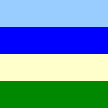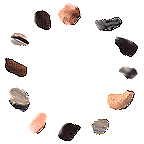 by the artist.
by the artist.

 <i> i o l a </i> (foreground) |
 hypomnemata (middleground) |
 undergrowth (background) |
 by the artist.
by the artist.

 <i> i o l a </i> (foreground) |
 hypomnemata (middleground) |
 undergrowth (background) |
My primary focus at this time is the development of a project with the general title "Tumbleweed" that is organized to be accessed through a foreground platform, an index and guide called <i> i o l a </i> (and yes the html tags for italics are part of the title) but will have any number of methods of access in the future. The URL is:
http://artnetweb.com/iola"Project Tumbleweed" is an evolving investigation of the possibilities of a personal multi-dimensional on-line ecology based on potentiality rather than simulation and is a para-site of the collaborative domain artnetweb.com as well as the Internet. It will be one model for what many think of as a "virtual museum." I use this term with hesitation but acknowledge that it has become common to think of an online representation as something virtual, meaning unreal, and is a result of thinking in terms of multimedia CD-ROM and other forms of digital delivery that have become current but are not necessarily applicable to a networked environment like the Internet.
My definition of virtual would be closer to "universal," meaning a museum of the possible. In the end "unreal" and "universal" may mean the same thing in that the term "universe" is a metaphor for what we can't wholly comprehend, a lie we tell ourselves to avoid thinking the unthinkable. So a better term would be potential and that's why I subtitle this project "a potential museum," a "house of the muses" that is based not on a collection, education, connoiseurship or any other aspect of our current institutions but on what the muses (the daughters of memory) promise -- potentiality.
As for the use of "tumbleweed" the only reason for using it I can give now is that a tumbleweed only exists in motion, when still it's a dead bush. This may not be very illuminating (or even logical) but it is my perogative as an artist to be oblique.
+-+-+-+
"<i> i o l a </i>" is the foreground (red) platform and is a personal curated interface with the rest of the Internet through links to articles, e-zines, books and projects updated on a daily basis. It is an "entrance" to the rest of the project yet most of the links will take a visitor elsewhere. Most institutions want to keep visitors within their own "space". What they don't take into consideration is that in the physical building people do not materialize in the doorway, they come through some mode of transportation -- walking, taxi, bus -- and from the "outside". The transition from "outside" to "inside" is metaphorical on-line and the advantage of linking would seem to be the ability to link in both directions. The advantage is that it creates a space of entering with the possibility of going elsewhere and that encourages return visits. The entrance has a use other than as an aesthetic decompression chamber.
From this platform you can enter the "Hypomnemata", or middleground (green) platform, which could also be considered as a form of "studio" for me where I work on projects and keep the information and material for those and future projects. In the future this platform will be spatial using VRML, Dynamic HTML and/or whatever tools are available for developing spatial metaphors. I am intentionally trying to avoid thinking in terms of 3-D modeling and have opted to start with the fourth dimension, time (or chronology in this case) in a very simple representation. Some of the projects within this platform investegate time further in terms of tempo, looping and rhythm using gif animation and javascript.
From the "Hypomnemata" you may enter the "Undergrowth", or background (blue) platform, which consists of journals from the past fifteen years I am converting to digital form and uploading. This will eventually include images and be a relational database where my past, or some kind of history, can be reconstituted.
There are three kinds of spatial articulation explored in the project and is an attempt to add to the work of my associates who are working with 3D modeling and VRML:
1. Literary (<i> i o l a </i>, Hypomnemata, Undergrowth)There are three kinds of temporal articulation explored in the project:
2. Perspective (foreground, middleground, background)
3. Image (red, green, blue)
1. Memoria (Past)
2. Intelligentia (Present)
3. Providentia (Future)The entire project will have another platform called "I-90" that will be a method of passage through the environment but I've yet to work through that in any significant way.
The "Tumbleweed" project is an outgrowth of the "artnetweb" site that I developed with Remo Campopiano (http://artnetweb.com).

 <i> i o l a </i> (foreground) |
 hypomnemata (middleground) |
 undergrowth (background) |
The TUMBLEWEED has three views:
|
||
| . | . | . |
Valdimir Nabokov heard words in color, a sensation he said was produced by his orally forming a given letter while imagining its outline -- the long "a" of English had the tint of weathered wood, while the French "a" evoked polished ebony. This condition of audition colorée was first discussed by an albino physician in 1812, in Erlangen. ("Speak, Memory", pages 34-5)
 "I-90" is a pathway through "TUMBLEWEED", represented as an image of a tholos of twelve stones. | ||
ROBBIN MURPHY
contact: murph@artnetweb.com
This site created on 27 October 1997, revised 9 October 1999